The color green has come to represent the movement to be more environmentally conscious. We now speak of “going green” and “green energy,” referring to practices which reduce or eliminate environmental impact. Over the course of the past decade or so, concern has grown over the impact of global carbon emissions and power usage, and many corporations have taken steps to reduce their environmental impact.
Every little bit we do to reduce emissions helps the overall world environmental impact. Numerous small, household improvements, like using more energy efficient lighting, add up to make a large difference. The biggest users of electricity are large corporations that operate factories, data centers, large transportation networks, massive event centers, and other power hogging machinery. These large companies can use as much power as thousands of households, and it makes a massive difference when they take steps to reduce energy waste.
Often it isn’t practical for these companies to actually use green energy. For instance, a good location for a data center might be an isolated area in a cool climate – data centers tend to produce a lot of heat. It could be incredibly expensive to try to set up a power plant nearby, and there might not be enough wind or sunlight to turn into energy.
Green Tags are one way large companies can reduce environmental impact. When a company buys a Green Tag, they pay for renewable energy to be produced elsewhere and fed into the national energy grid. This energy is more expensive to produce, but the cost is paid by the corporation, and the energy is delivered to nearby residents at the same price as normal power. The overall impact on energy usage is that more power comes from renewable resources, even if that power isn’t directly being used by the company paying for it.
Sometimes this idea is hard to grasp. Sure, it’s nice of a company to pay for renewable energy, but if they aren’t actually using it, does it make a difference? Although it can be difficult to grasp this intangible ideal, think of it this way – if everyone in the world bought green tags, all the energy produced would be green. You might be funding energy production in another location, but everyone working together and doing this would eliminate wasteful, high carbon emission energy production.
How does HostPapa fit into this scene? HostPapa adheres to the principles of Green Web Hosting. HostPapa buys enough Green Tags, certificates that they’ve funded renewable energy production, to cover 100% of their energy usage. Their energy consumption is measured by an independent company, and HostPapa is billed for the price of enough Green Tags to completely replace their energy use with renewable energy, sent somewhere else on the grid.
Globally, IT companies are responsible for 2% of carbon emissions (source). As part of this significant portion of global energy usage, HostPapa takes pride in using green energy through the purchase of Green Tags.
If you want to join HostPapa in protecting the environment and using renewable energy, you too can purchase green tags for your home or office energy consumption. This really does make a difference overall, and you can share your decision with your family and friends, and invite them to follow you in using safe energy.
If you happen to run a website, a great way to use green energy is to host your website with HostPapa. You can rest assured that HostPapa is completely carbon neutral, and your Internet traffic isn’t impacting the environment. With HostPapa’s affordable hosting plans, the cost to you will be minimal, but the difference you make won’t be. To learn more about HostPapa, visit HostPapa.ca.


 (416) 421-3178
(416) 421-3178

